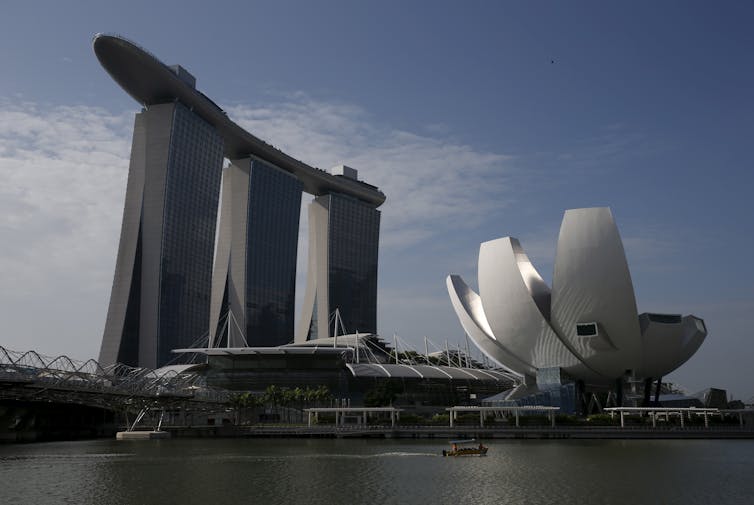You can drive across Singapore (population 5.5 million) in 45 minutes – roughly the same time it takes to reach Gawler from the Adelaide CBD. As an equatorial island, the climate is warm all the year round, and as a value-adding trading hub the commercial atmosphere is all-pervasive.
So far, so un-Australian. But if the surface features of the Singaporean state do not lend themselves to comparison with our own, less obvious aspects do. Culture, for example.
As a researcher, I have never taken too seriously the claim that Australia is part of Asia. It is a proposition that strikes me as both geographically questionable and psychologically untrue. Australia is part of a global polity in which a number of countries, some Asian, are now more closely entwined with our social development and economic fate than they were previously.
The rise of China is an international not a regional phenomenon, while Brexit is a European event that affects Australia in significant ways. The tyranny of distance has been deposed. Welcome to the anarchy of connectedness.
Comparisons with Singapore don’t have to lie at the lofty level, however. Consider that Singapore, like Australia, is a country of relatively recent origin, British influenced and capitalist-minded. Like Australia, it was an administration before it was a government, and this quirk of development affects both the tone and substance of public life.
My Australian friends would hate me saying it, but both Australia and Singapore operate in an atmosphere of compliance, where a high level of trust is still accorded to politicians and the political domain, however loudly we complain about them. And before the pshaws start sputtering like winter hail, take a look at the US and the UK to see what happens when that trust really breaks down.
Twenty years ago, Singapore launched the Renaissance City Plan, the outcome of a report by its Advisory Council of Culture and the Arts. It was a watershed moment in Singaporean cultural policy, in the same way that Creative Nation was a significant reference point for Australia.
A great deal of cultural infrastructure was built in a hurry, from scratch. The 1980s in Singapore resembles nothing so much as Australia in the 1970s – an edifice complex of unusual intensity and scope, with arts centres, galleries, museums and training schools quickly constructed.

Today, Singapore faces the same question as Australia: what to do with these? Do we treasure them, measure them, upgrade them or hand them over to the private sector? As rich countries that bought many of their cultural organisations as a full suite, Singapore and Australia must come to terms not only with the activities that culture comprises, but with the public value it represents (usually it happens over a longer haul: first we value, then we build).
Singapore, like most Australian capital cities, now has one of everything: a flagship museum, a flagship gallery, a flagship performing centre, a flagship library. In 2015, there were 5,412 arts and cultural organisations, and 1.5 million tickets sold to different performing arts events. A 2012 Strategic Review commented:
We stand at the brink of another transformation in our cultural landscape … After decades of hard work to achieve our prosperity and security, we now have the cultural foundation and economic means to springboard to our artistic and cultural success … Arts and culture will secure our identity amidst the multiplicity of global influences today, even as we remain open to the world.
This is the challenge for Singapore and Australia – rapidly developed cultures hedged about by ones of longer standing: staying open while remaining distinct. Numbers and policy nostrums don’t describe the fugue headspace that artists in particular occupy. We don’t have to call it “post-colonial”, which perhaps wraps things up too neatly. But it is certainly affected by a colonial legacy. In the case of Australia, it creates a dual cultural consciousness, one that is both nationalist and European. In the case of Singapore, it produces a multi-ethnic weaving of four very different racial groups.

If you want to know how people think, look at what makes them laugh. On a recent trip to meet researchers at the Singapore Management University, I was invited to Alfian Sa’at’s new play Geng Rebut Cabinet at LaSalle College of the Arts.
Geng Rebut Caninet is a fast-paced, caustic, satirical reversal in which the Malays are the dominant racial group and the Chinese are in the minority. The dialogue mixes Malay, Mandarin and English in a tossed salad of low humour, political swipes and razor sharp ideas (think David Williamson in the early 1990s: Siren or Money and Friends).
The cultural imaginary of Singapore is self evidently an ongoing negotiation of different views and values. Instability and complexity are its reality, fusion and diversity its job of work. It is this which it has in common with Australia, and which affects all cultural organisations in the nation. It’s at the institutional level, where the nuts and bolts of cultural stuff gets done, that the comparison can be fruitful.
Singapore is talked about as a one-party state, controlled and controlling. But it is now liberalising, and some of its cultural offerings demonstrate that. As for Australia, we appear to be retreating into a defensive insularity, one that would rather lock up than look out (recall Tony Abbott’s “whose side are you on?”)
When I addressed a Singapore arts industry forum, there was astonishment at the story of last year’s savage budget cuts to the Australia Council and the subsequent Senate inquiry. Not even the most brazen Singaporean minister would try that kind of malarkey.

